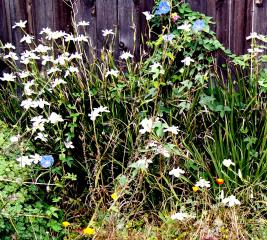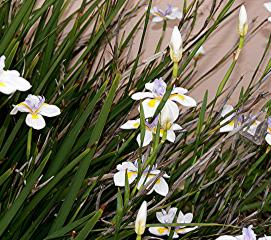hoodat
Garden Addicted
How this plant ever got tagged as a lily when it is so obviously an iris is beyond me.
I know of no other plant that can take such a beating and come up blooming. Here in Southern California you often see it used around public buildings where it gets walked over and has bicycles tossed into it. It will bloom even when seldom if ever watered but like most plants looks better with occasional watering. I've never had to fertilize it although I occasionally do.
It is a wild form of iris that grows in Africa. The flowers are much daintier than most iris, reminding me of a flock of butterflies.
It blooms and then rests to bloom again a short time later. The name comes from the idea that it blooms every fornight but that depends on your zone. When it is in bloom the whole plant is covered in blossoms. Don't cut back the stem after it flowers unless you want some for cut flowers. The same stem will bloom again. When it is used up the stem dies back and that's when it should be cut out. The pictures show some dried stems to give you an indication. The last bloom on the stem will produce a seed capsule about the size and shape of a pigeons egg. When the seeds are ripe the stem dies and the capsule opens to drop the seeds. It seeds itself very freely or you can split up the clump and replant the divisions any time.
The odd thing is that seperate plants synchronize with each other and all bloom and rest at the same time. Even plants 50 feet apart will synchronize. This, plus the fact that it is insect free makes it an ideal foundation planting where you want plants about 4 feet tall. It is also a great background plant for your other flowers to show against. The leaves are dark green. In the picture you can see that mine is even holding its own against morning glory and that takes some doing.
It is recommended for zones 8 through 11.


I know of no other plant that can take such a beating and come up blooming. Here in Southern California you often see it used around public buildings where it gets walked over and has bicycles tossed into it. It will bloom even when seldom if ever watered but like most plants looks better with occasional watering. I've never had to fertilize it although I occasionally do.
It is a wild form of iris that grows in Africa. The flowers are much daintier than most iris, reminding me of a flock of butterflies.
It blooms and then rests to bloom again a short time later. The name comes from the idea that it blooms every fornight but that depends on your zone. When it is in bloom the whole plant is covered in blossoms. Don't cut back the stem after it flowers unless you want some for cut flowers. The same stem will bloom again. When it is used up the stem dies back and that's when it should be cut out. The pictures show some dried stems to give you an indication. The last bloom on the stem will produce a seed capsule about the size and shape of a pigeons egg. When the seeds are ripe the stem dies and the capsule opens to drop the seeds. It seeds itself very freely or you can split up the clump and replant the divisions any time.
The odd thing is that seperate plants synchronize with each other and all bloom and rest at the same time. Even plants 50 feet apart will synchronize. This, plus the fact that it is insect free makes it an ideal foundation planting where you want plants about 4 feet tall. It is also a great background plant for your other flowers to show against. The leaves are dark green. In the picture you can see that mine is even holding its own against morning glory and that takes some doing.
It is recommended for zones 8 through 11.


